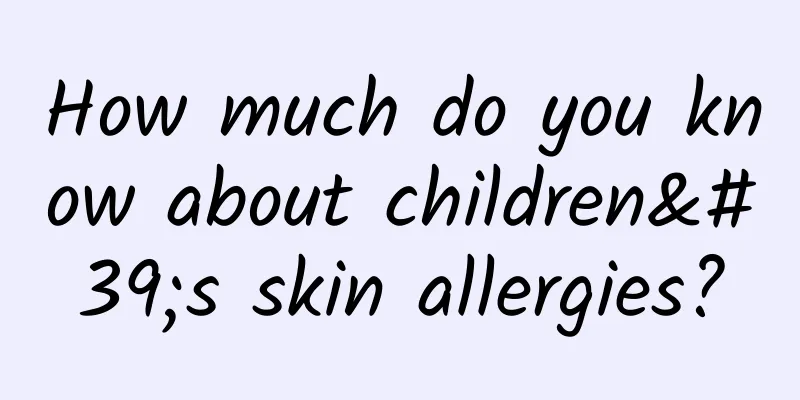How much do you know about children's skin allergies?

|
July 8, 2020 is the 16th World Allergy Day. Today, Dr. Huo Zijian from the Department of Pediatrics at Beijing University of Chinese Medicine Oriental Hospital will introduce children's allergic skin diseases. With the changes in air pollution, environment and lifestyle, the number of people suffering from allergic diseases is gradually increasing, and the disease occurs at all ages, especially in children. For children, the earliest allergic reaction is eczema. In addition, skin allergic diseases such as urticaria and drug rash are also common, with rash and itching as the first symptoms, which are easy for parents to find. Children's skin allergies are mainly caused by various exogenous allergens, such as physical factors (friction, pressure, cold wind, heat, sunlight, etc.), contact factors (pollen, dust mites, animal dander, juice of certain plants, chemicals, new clothes, etc.), food (fish, shrimp, eggs, milk, soy products, mangoes, food additives, etc.), drugs (penicillin, cephalosporin antibiotics or certain Chinese medicine ingredients, etc.) and mosquito bites. 1. Eczema Eczema is a recurring skin disease in infants and young children. The acute phase is mainly manifested by skin flushing, exudation, and obvious itching. In the later stage, the skin becomes dry, cracked, crusted, and thickened. It is mostly symmetrically distributed in irregular locations, and is more common on the scalp, face, auricle, and the extension or flexion side of the limbs. Eczema is closely related to the imperfect skin barrier function, so parents should pay attention to moisturizing their children's skin and applying moisturizers. For treatment, some topical hormone ointments and oral antihistamines should be used under the guidance of a doctor. Because eczema recurs repeatedly, it is related to the child's allergic constitution. Traditional Chinese medicine treatment can take into account both the symptoms and the root cause, which can not only relieve the child's symptoms, but also improve the child's allergic constitution and reduce the number of attacks. 2. Urticaria Urticaria is a common allergic disease in children, which is what we commonly call "wheals". After children come into contact with allergens, they will soon develop red "wheals"-like rashes of varying sizes and irregularities all over their bodies. The itching is unbearable, and they are always scratching and rubbing. Generally, they come and go quickly, but parents are reminded that urticaria sometimes not only manifests itself on the skin, but may affect multiple systems, such as the respiratory system, circulatory system, and digestive system. Children may experience shortness of breath, difficulty breathing, increased heart rate, abdominal pain, diarrhea, etc. Parents should not underestimate it. The causes of urticaria are complex and diverse. When exposing your baby to new foods or things, pay more attention to the child's behavior. Once an allergic reaction occurs, the first thing to do is to separate the child from the allergen, and seek medical attention in time, and use anti-allergic drugs under the guidance of a doctor. 3. Drug rash Drug rash is a skin and mucous membrane reaction caused by drugs entering the human body through oral, topical, inhalation and injection. For children, any drug may cause drug rash. The most common drugs in clinical practice are cephalosporin antibiotics, antipyretic and analgesic drugs and some traditional Chinese medicines. The rash of drug rash has various manifestations and no typical manifestations. It can be seen as measles-like, scarlet fever-like or urticaria-like. In severe cases, there will be exfoliative dermatitis. Some children also have fever, headache, general discomfort, etc. It is not easy to distinguish from rashes caused by other diseases. It is recommended that parents record the names of the drugs used by their children in detail to help doctors analyze the causes and make a clear diagnosis as soon as possible. Daily care for skin allergies: 1. Avoid contact with allergens: Pay more attention to what foods your children eat or what items they touch that cause skin allergy symptoms. You can also understand the allergens by testing them and try to avoid them in daily life. 2. Take a moderate bath: The water temperature should not exceed 40℃ when taking a bath. High water temperature will irritate the skin. Low water temperature can relieve the child's skin itching (but be careful not to catch a cold). Try to avoid using soap or shower gel when taking a bath, as they will irritate the skin. 3. Dietary precautions: Do not let children eat spicy and irritating foods during skin allergies, and avoid eating some foods that are prone to allergies, such as fish, shrimp, peanuts, mangoes, etc. Breastfeeding mothers should also pay attention. 4. It is recommended to dress children in pure cotton, soft, breathable, and zipper-free clothes to reduce the irritation of children's clothes on the skin. When parents hold their children, they should also wear pure cotton, zipper-free, and hard-free clothes to avoid irritation and friction on the children's skin. |
Recommend
Can correct kneeling method cure the disease caused by sitting out?
Recently, the editor has been complaining about b...
It's just a dust mite allergy, why did I go into shock after eating pancakes? Understanding pancake syndrome
Case: A 15-year-old girl soon developed symptoms ...
Sexual intercourse during interferon therapy
Interferon plugs are immune substances released b...
The fastest way to relieve itching
Vulvar itching can generally be treated with exte...
Can I eat buckwheat noodles during breastfeeding?
During breastfeeding, the mother's lifestyle ...
What should I do if the gestational sac is in the ovary at 45 days of pregnancy?
At 45 days of pregnancy, the pregnant woman is st...
Location map of costochondritis in women
Diseases like costochondritis are more common amo...
What is the reason for dark color of menstrual period
Many women have dark menstrual color due to exces...
The fortune of a woman with exposed nostrils
The nose is also known as the ancestor of the nos...
What causes vaginal itching and leucorrhea with odor?
Vaginal itching and abnormal leucorrhea are the m...
How long is the appropriate confinement period?
Confinement after childbirth has always been a tr...
What causes vaginal bleeding and abdominal pain in early pregnancy?
Vaginal bleeding and abdominal pain are common sy...
How to regulate uterine cold
Whether it is cold or hot, female friends must do...
Where should you “cover” in spring? Remember these three points
As the saying goes, "Keep warm in spring and...









